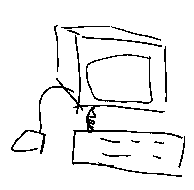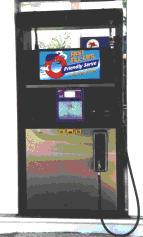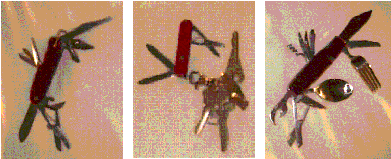
Figure 1: A typical 15-second drawing of "a computer."
Absorbing and Squeezing Out: On Sponges and Ubiquitous Media
Bill Buxton
Alias | Wavefront Inc. & University of Toronto
Toronto, Canada
ABSTRACT
We argue that the current notions of television, interactive television and personal computers are inadequate to support the potential offered by the ongoing convergence of media. To reap the potential that is there, we must rethink the nature of not only the appliances with which we interact, but where they are located.
Our concerns are the increasing complexity of such appliances, on the
one hand, and strategies for their redesign, on the other. Given the influence
that the physical design and location of the appliance plays in our perception
of them, our main argument is that the best way to reduce complexity and
improve design is by rethinking these very same things: physical design
and location.
So, for example, the question is not, "How do we do interactive television?"
Rather, it is, "How do we redefine what a television is and where it should
be?" It is not, "How do we make a usable multimedia computer?" It is, "How
do we make computers disappear, and where do we want access to computation?"
In short, we argue that the goal should not be to make new applications
run in the existing appliance, or box. The solution to achieving the potential
of technological convergence is to completely redesign the box, or better
yet, make it disappear into the ecology of our living space altogether.
This is neither a case study nor a conventional research paper. Rather,
it is a discussion of issues that have emerged from a larger body of research
and simply living with experimental systems - issues that appear to have
relevance in helping guide us from the conventional appliance model of
technology towards something more transparent, but effective.
In the same room where this operated, there was a PDP-11/40, that had a card reader, a tape drive, and D/A converters. Students from the Faculty of Music who were studying electronic and computer music used this latter system for their course work. They punched a stack of cards defining their job and brought them to the I/O clerk who would then feed them into the 11/40. If all went well, the music software would grind out the samples of the resulting music and write them onto the tape drive. This tape would then be "played back" through the D/A converters and recorded onto audio tape. Normal turn around was overnight. (Incidentally, this procedure was typical for computer music at the time.)
Realizing the discrepancy between these two music systems, I approached the Dean of the Faculty of Music, who also directed the electronic music program. I offered that his students would be welcome to use my system for their course work, rather than the batch system. His response was, "No, because if they use your system they will not be learning to use a computer, and what they do learn will be of no use when they graduate."
What this response said to me was that his view of a computer was dominated
by the process of interaction and the input/output devices through which
this interaction took place. This was despite the fact that both systems
were running on virtually identical CPUs. Now this was an intelligent person,
literate in technology. Rather than surprising me, his response simply
emphasized the degree to which what he saw, felt and heard shaped his model
of computers and computer music.
Exercise 1: In 15-20 seconds, draw a computer.
Exercise 2: Imagine that it is 1960. Again, in 15-20 seconds, draw a computer.
I have had over 500 people do this. In response to the first exercise,
the overwhelming majority draw a monitor and a keyboard. A smaller but
significant number draw a mouse as well. What is interesting is that relatively
few actually draw the box that contains the CPU, itself. A typical response
is illustrated in Figure 1.

Figure 1: A typical 15-second drawing of "a computer."
The responses that I get to exercise two are more varied. (I suspect that this is due to the likelihood that the majority of respondents were not alive in 1960, much less using computers.) What people typically draw looks much like a collection of refrigerators and washing machines, intended to represent the keypunch machines, card readers, tape drives and line printers of the era. A representative example is shown in Figure 2.
Virtually nobody will draw a schematic of an arithmetic/logic unit (ALU), and/or a set of data registers interconnected by a data and an address bus. From an engineer's perspective, this may be the "correct" response. (At least it would more-or-less lead to the same result in each exercise.)
The consistency of the results are very telling. The key to their significance lies in the observation that what people draw are the input/output devices of the computer, not the computer itself. What this emphasizes first is the power of what users see and touch (the input/output devices) to shape their mental model of the system. Second, it reminds us that these very same input/output transducers are "accidents of history" and therefore candidates for change.
Figure 2: A representative 15-second drawing of a circa 1960
"computer."
These are two of the most powerful observations that a designer of computers could have. What they say is:
From these simple exercises emerges the power to fundamentally change the perception of computation forever. And what is true here for computation, is equally true for television.
- You can change the input/output devices.
- By your choice, you can have a huge influence on shaping the end user's mental model of the system.
From twenty paces, all desktop computers running a GUI are indistinguishable, regardless whether they are PC's running Windows, UNIX boxes running Motif, or Macintosh's running the Finder. Furthermore, portables are simply shrunken-down desktop machines. There are no fundamental, or first-order, design differences across the bulk of the currently installed base of systems.
But what of the users? How consistent are their skills or needs? Is the same basic tool equally suited to the graphic artist, engineer or secretary? The question is rhetorical. What should be evident is that we cannot get to the next level until we begin to tailor systems to the specific skills, tasks and contexts of specific users.
Remembering our two drawing exercises, this cannot be reduced to "a
simple matter of programming." It is a need to fundamentally redefine the
nature of what a computer is. (But luckily, from those very same drawing
examples, comes the keys to doing so.)
Think of television. We think of it in terms of the appliance known as the "television set." (Unfortunately, because of the strong relationship between the medium and the appliance, the same name applies to both.) In almost every article that I have read about the next generation of television, the author remains fixated on the conventional scenario of the TV appliance in the living room of the home. About the only things that are new are 500 channels and a "set top box." Applications, such as video on demand and home shopping, are then squeezed into this poor, over-worked and under capable technology. How much better if we break out of the box. Consider two examples.
Instead of "home shopping," what if interactive television were to bring you "pump-side shopping?" While you were standing beside your car filling up with petrol (truly a captive audience), the pump itself would be the "box." By packaging it in a gas pump and moving it from the living room to the roadside, the entire perception of the system would change, while the underlying technology would be almost identical to what might be found in the home. Figure 3, for example, illustrates a prototype of just such a pump which is being field tested today.

Figure 3: A prototype gasoline pump with integrated touch screen and media delivery mechanism for "pump-side shopping." (TouchCom Technologies).For my next example, I want you to think about the recent announcement by companies such as Sony, NEC, Fujitsu and Matsushita of pending large flat plasma displays for televisions. A unit available from Fujitsu, for example, is illustrated in Figure 4. So now that this technology is coming, the box will change. But what does that mean? What can we learn from this?
Figure 4: A flat-panel display mounted on wall (Fujitsu).
If you believe what I've been saying so far, then you might be asking yourself, "If the box is changing, and moving from the floor to the wall, won't that change our perception of the nature of TV?" I believe the answer to be yes. Let's do another exercise that illustrates why:
Exercise 3 : Write down what is the largest interactive display in your house, and where it is located.
I can hear the pens already, all scratching in unison, "the television."
Well, by now you should know me better than that. I bet that the real answer,
on reflection, is the refrigerator in your kitchen!
If it is anything like mine, illustrated in Figure 5, it is covered
with calendars, memos, appointments, reminders, children's art and all
kinds of other paraphernalia. And let's be clear, it is not just a display.
Just notice how dynamic the information on it is.
So I ask you, is not the fridge door one of the most logical places
to put one of these large flat displays? Think about being able to put
notes on it with a stylus, interact with it by touch, and read it or place
things on it remotely, since - of course - it will be on the Internet as
well as cable.
Now if you think that this, or anything like this is remotely likely
in the next 5-10 years, then you are forced to ask, "How does this affect
my conception of what television is and could be?" "How might it affect
what I do in the next 2 years?"
Figure 5: The refrigerator seen as a domestic interactive
information appliance.
I am not saying that home shopping, set-top boxes and video on demand
will not come. What I am suggesting is that they are such a small part
of what the future is bringing that if we spend all of our time focusing
our conceptual models on them, we will miss the heart of the gold mine
while we are picking up little pieces around the edge.
Figure 6 illustrates this point by analogy. It shows three pocket knives that I own. The one on the left has a number of gadgets built in, including scissors, a screw driver, and a cork screw. Because of the resulting size, I don't carry it in my pocket; rather, it lives in my briefcase. Consequently, I can only make use of it when I have my briefcase with me.
The one in the middle has far fewer gadgets and therefore, it is much smaller. It fits in my pocket and so I have it with me nearly all the time. Consequently, despite lower "functionality" I use it far more often. The left knife is like my portable computer, which also lives in my briefcase. The middle one is more like my watch, which is almost always with me.
The third knife, on the right, has the most functionality, but ironically, is the least useful. In fact, its lack of usefulness is a direct result of overloading too much functionality into one device. I am going to argue that this is precisely the same problem that afflicts multimedia computers and overburdened television sets.
As a start, what I do with the knife on the right is ask someone to find the wood saw. This can take as long as five minutes. This illustrates that as functionality increases, the harder it is to find what you want, or discover what is possible.
However, there are deeper problems. Notice that, despite all of the different functions available, only one person can access them at once, and even then, only one function at a time. Again, the analogy to multimedia computers and interactive television is applicable. Despite being able, in theory, to support shopping, learning, games, video on demand, research and telecommunications, only one of these functions can be accessed at a time per appliance, and there is generally only one controller available.
One could argue that this can be easily solved by having multiple appliances around the house. After all, don't most houses already have more than one television?
There are two problems with this argument. The first is the assumption that with all of the new capability, the costs will not be substantially higher, so that consumers will be able to afford multiple information appliances. The second relates back to the Henry Ford design issue: there is an assumption that even if we could afford to have multiple interactive televisions or multimedia computers, that those are the appropriate appliances for the task.
We can do another exercise to gain some insight into these issues:
Exercise 4: Make a list of two columns. In the left column, list each of the gadgets (knife, saw, corkscrew, etc.) in the third knife in Figure 6. In the second column, list the room in the house where the function associated with that gadget is normally undertaken.When I do this exercise, the list looks something like this:
What I want to emphasize here is the relationship between functionality and the location where it is delivered. What this suggests is the provision of a diverse range of simple specialized appliancettes where they are needed and in a form appropriate to their use and user, rather than some Henry Ford style super appliance. To convince yourself of this argument, just ask, would you not rather have a simple knife, fork, corkscrew and nail file in the appropriate rooms, rather than carry around the fat knife in Figure 6, or have knives like that distributed throughout the house? The knife solution is patently absurd. But isn't that precisely what we are doing with interactive TV and multimedia computers? Perhaps it's time to rethink our approach.
Utensil Location Saw workshop spoon kitchen fork kitchen scissors sewing room leather punch stable nail file bathroom corkscrew dining room

Figure 6: Three pocket knives with varying amounts of "embedded functionality."
There is great potential in the emerging technologies. There is also a great risk that we will miss the chance of actually achieving this potential.
The current models of computers and television are dominated by too narrow a range of appliances - so much so that we can neither separate the medium from the appliance (for example, "television"), nor develop any unifying models which tie together the different pieces of the story (for example, television and the Internet).
We have to push harder, and on a wider field of view. If this essay
has helped in bringing this about, even a little, it has been worthwhile.
The research underlying this essay has been generously supported by
Xerox PARC, the Ontario Telepresence Project, Alias | Wavefront, the Information
Technology Research Centre of Ontario and the Natural Sciences and Engineering
Research Council of Canada.